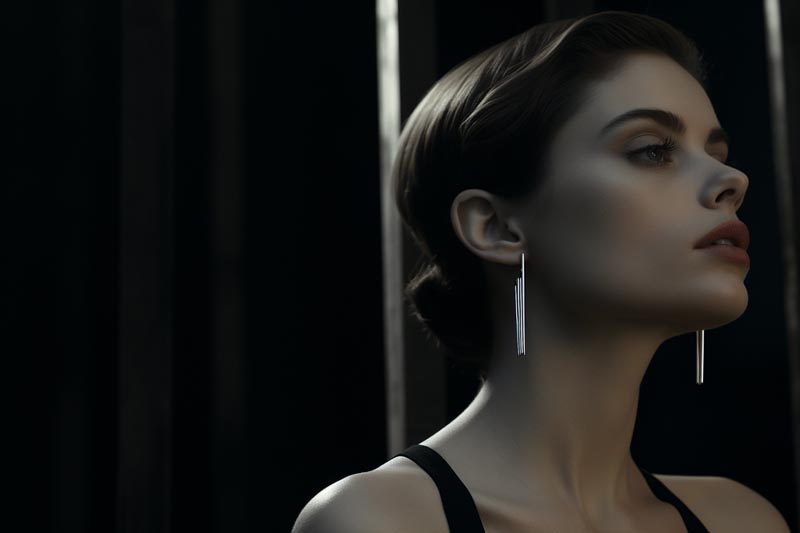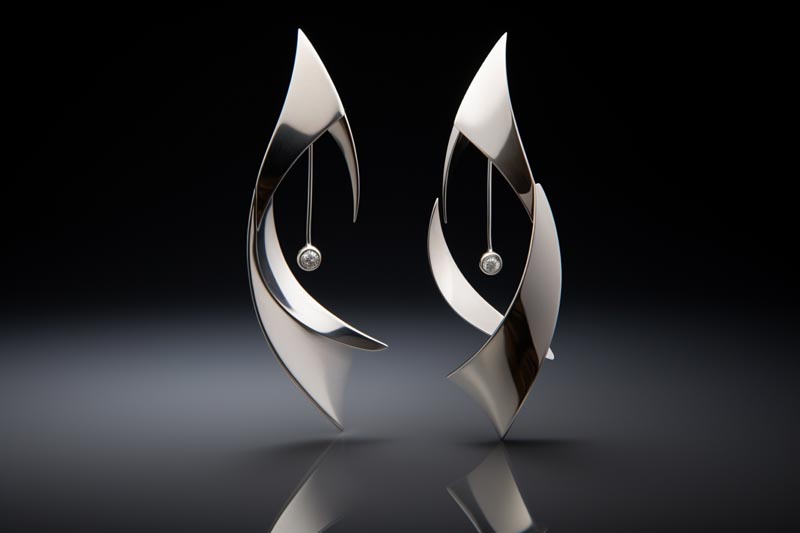
Earrings have been a symbol of style and sophistication for centuries, adorning the ears of countless individuals seeking to enhance their charm. However, this glittering accessory can occasionally cause concern for sensitive skin. The culprit? Certain metals are traditionally used in crafting earrings, leading to discomfort and allergic reactions. Enter the solution transforming the jewelry industry—hypoallergenic metals for earrings.
Welcome to Joias & More, where we believe style should never compromise comfort. We understand that everyone deserves to adorn themselves with beautiful pieces, so we’re dedicated to informing you about all jewelry aspects. Today, we dive into the fascinating world of hypoallergenic metals, a game-changer in the earrings field, offering a harmonious blend of elegance and ease.
Join us as we explore the future of comfortable jewelry, underlining why hypoallergenic metals for earrings are more than just a trend—they’re a testament to a future where anyone can enjoy the allure of earrings, free from the worry of allergies. Let’s get started!
Understanding Hypoallergenic Metals
‘hypoallergenic’ is a blend of two words – ‘hypo,’ which means ‘below normal,’ and ‘allergenic,’ meaning ‘causing allergies.’ Therefore, hypoallergenic refers to substances less likely to cause an allergic reaction. When it comes to jewelry, hypoallergenic metals are relatively unlikely to cause an allergic reaction, making them ideal for people with sensitive skin or known metal allergies.
Metal allergies occur when the body’s immune system mistakenly identifies the metal as a harmful substance, triggering an allergic reaction. Symptoms can range from mild to severe, including itching, redness, rash, or swelling where the metal touches the skin. In the context of earrings, this would typically be around the earlobes or the piercing itself.
Common Allergenic Metals in Earrings
Unfortunately, many popular and economically advantageous metals used in jewelry are potential allergens. Nickel is the most common culprit, causing contact dermatitis in a significant number of people. Frequently, cheaper jewelry or those claiming to be ‘silver’ or ‘gold’ may be alloyed with nickel to cut costs.
Other metals that may cause allergies include cobalt and chromium. Cobalt is often found in alloys used for making jewelry, while chromium is used in tanning leather and can sometimes be found in leather earrings.
These allergic reactions can cause discomfort and can even deter some people from wearing earrings altogether. But, as we delve deeper into the world of hypoallergenic metals for earrings, we’ll see that this doesn’t have to be the case. The world of jewelry is evolving, and the rise of hypoallergenic metals is paving the way for a more inclusive and comfortable future.
The Future of Earrings: Hypoallergenic Metals
In the ever-evolving landscape of fashion and style, a significant shift has emerged with the rise of hypoallergenic metals for earrings. The use of these metals signals a new era where jewelry makers prioritize not just the aesthetics of their creations, but also the well-being and comfort of the wearer.
While traditional metals offer undeniable charm, they often come with the risk of allergic reactions for a considerable number of individuals. In contrast, hypoallergenic metals provide a safer alternative, ensuring that everyone can wear their favorite earrings without fear of irritation or discomfort. In this sense, hypoallergenic metals represent the future of comfortable jewelry – a future where beauty and health go hand in hand.
Popular Hypoallergenic Metals for Earrings
To give you a clearer understanding of your options, let’s explore some of the popular hypoallergenic metals that are transforming the world of earrings:
- Stainless Steel: A widely popular choice, stainless steel is often used in high-quality jewelry due to its durable nature and resistance to rust and tarnish. It’s also hypoallergenic, making it an excellent choice for those with sensitive skin.
- Titanium: Known for its exceptional strength-to-weight ratio, titanium is another superb option. It is highly resistant to corrosion, very durable, and unlikely to cause allergic reactions.
- Gold (14k and Higher): While not all gold is created equal, higher karat gold, typically 14K and above, is generally considered hypoallergenic. This is because such gold has fewer alloys that might cause irritation. It’s worth noting, though, that white gold often contains nickel and may not be hypoallergenic.
- Platinum: This prestigious metal is both rare and valuable. More importantly, for our discussion, it’s hypoallergenic. Platinum’s natural white sheen doesn’t fade or change color, making it a lifelong companion for your ears.
- Sterling Silver: Sterling silver is silver alloyed with another metal to improve its durability. As long as the other metal isn’t nickel or another allergenic metal, sterling silver can be a great hypoallergenic choice. Always look for sterling silver marked as .925 silver.
The decision to opt for hypoallergenic metals for earrings is an investment in your comfort. The above list provides a brief overview of the most common options available, each with its unique benefits and aesthetic appeal. It is proof that you can enjoy wearing earrings without the fear of allergies, marking a significant milestone in the evolution of comfortable jewelry.
Consumer Guide: How to Choose Hypoallergenic Earrings
Navigating the world of jewelry can be a daunting task, especially when you’re looking for pieces that won’t irritate your skin. Here are a few tips to guide you in choosing the right hypoallergenic earrings:
- Check for Markings: Genuine hypoallergenic jewelry often has markings indicating the metal type. For example, sterling silver is usually marked with “.925”, and gold jewelry has a karat stamp such as “14K”.
- Ask the Seller: If you’re unsure about the materials used, don’t hesitate to ask the seller. Any reputable jeweler should be able to provide you with this information.
- Avoid Coated Metals: Some earrings are made from allergenic metals and then coated with a layer of hypoallergenic material. Over time, the coating can wear off, exposing the allergenic metal underneath.
- Consider the Price: While not a definitive rule, hypoallergenic earrings tend to be slightly more expensive due to the quality of metals used. If a deal seems too good to be true, it might be.
- Maintenance: Regularly clean your earrings to keep them free from dirt and oils that may irritate your skin. Be sure to keep them dry as certain metals can tarnish when exposed to moisture.

The Impact of Hypoallergenic Metals on the Jewelry Industry
The rising popularity of hypoallergenic metals for earrings has had a significant impact on the jewelry industry. Designers and manufacturers are shifting their focus towards these safer metals, leading to an influx of hypoallergenic offerings on the market.
This shift isn’t merely a passing trend; it’s a response to the growing consumer demand for comfortable and safe jewelry options. Hypoallergenic metals have been a game-changer, allowing jewelry makers to cater to a wider audience.
In addition, hypoallergenic metals have paved the way for innovation in jewelry design. Because metals like titanium and stainless steel are both hypoallergenic and durable, they are being used to create bold, modern designs that are as long-lasting as they are stylish.
Overall, the rise of hypoallergenic metals signifies a more inclusive future for the jewelry industry, where people with sensitive skin or allergies are no longer excluded from enjoying the timeless charm of earrings. It’s a testament to the industry’s adaptability and commitment to consumer well-being.
As we’ve journeyed through the world of hypoallergenic metals for earrings, it’s clear that these revolutionary materials are the future of comfortable, stylish jewelry. No longer does anyone have to endure discomfort or allergic reactions for the sake of fashion. With hypoallergenic metals, everyone can indulge in the joy of adorning themselves with beautiful earrings, worry-free.
At Joias & More, we’re passionate about ensuring that everyone can enjoy the allure of jewelry. Hypoallergenic metals for earrings are not just a passing trend; they are a symbol of an inclusive future where beauty is accessible to all, regardless of skin sensitivity or allergies.
As we continue to embrace these metals in jewelry making, we move closer to a world where the choice of earrings is based purely on design and personal style, and not restricted by the fear of allergic reactions. This is the promising future that hypoallergenic metals are creating in the jewelry industry—a future we’re thrilled to be a part of at Joias & More.
So, the next time you’re shopping for earrings, remember the importance of metal composition. Choose hypoallergenic metals for a comfortable and stylish experience. After all, fashion should be a source of joy, not discomfort.
Thank you for joining us on this enlightening journey. We hope it’s inspired you to embrace the future of jewelry where comfort and style unite in perfect harmony. At Joias & More, we’re committed to keeping you informed, helping you make the best decisions for your style and health. Stay tuned for more insights and remember, with hypoallergenic metals, the future of earrings is here.


